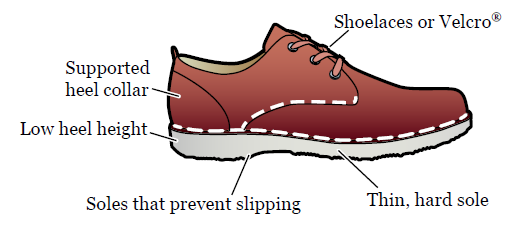This information explains how you can prevent falling by wearing safe shoes.
About shoe safety
The shoes you wear can affect your comfort and safety. Wearing unsafe shoes can make you more likely to fall and hurt yourself. You should always wear safe shoes, even inside your home, to help prevent falls.
What are safe shoes?
Safe shoes are shoes that fit you well, are comfortable, and are in good condition. They also have features that help keep you from falling (see Figure 1).

Safe shoes have:
- Heels that are 1 inch (1.6 centimeters) or lower.
- A way to close the shoe so that it stays on your foot (such as shoelaces or Velcro®).
- Thin, hard soles.
- Soles that prevent slipping.
- A supported heel collar, which grips your heel firmly.
What are unsafe shoes?
Unsafe shoes do not fit well, are uncomfortable, or are in poor condition. Unsafe shoes have:
- Heels that are higher than 1 inch (1.6 centimeters).
- No way of securing your foot in the shoe (such as slip-on shoes, slippers, clogs, or flip flops).
- Soft or thick soles.
- Soles that are slippery or worn out.
Tips for putting on and taking off shoes
If you have a hard time putting on or taking off your shoes, try the following tips to help:
- Use a shoehorn. Use a shoehorn with a long handle to help you put on shoes if you can’t reach down to your feet (see Figure 2). You can buy one from a retail drug store, such as CVS or Walgreen, or an online retailer like Amazon.
- Use elastic shoelaces. These are stretchy shoelaces. They let you slip your shoes on and off, so you don’t have to tie and untie them.
- Wear shoes with Velcro. Velcro is easier to tighten around your foot than shoelaces are.

If you have a hard time putting on or taking off shoes because your feet are swollen:
- Talk with your healthcare provider about treatment options, including physical therapy treatment for edema (swelling of your legs).
- Wear wider shoes that close with Velcro.
What to do if you can’t wear shoes
If you have foot pain and can’t wear shoes, talk with your healthcare provider. They will give you a referral to a podiatrist (foot doctor). The podiatrist can recommend orthotics (shoe inserts that give you extra foot support). They may also give you arch supports to help you feel more comfortable when wearing shoes.
